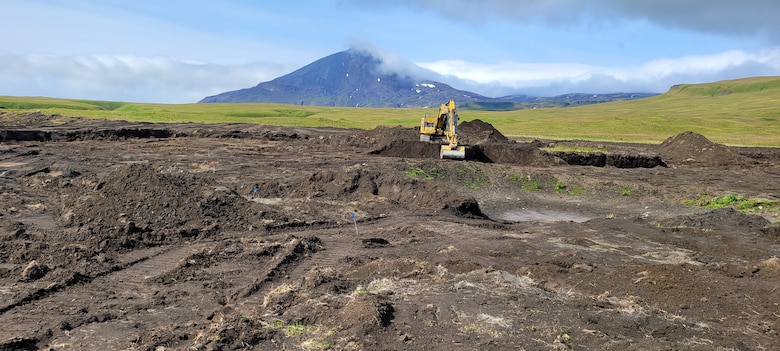05/09/2022 Stati Uniti, Alaska, Isole Aleutine
“If you ever come across anything suspicious like this item, please do not pick it up, contact your local law enforcement agency for assistance”
By Ms. Rachel Napolitan & Mr. Tom Findtner
Boom! Another explosion went off as a field crew for the U.S. Army Corps of Engineers – Alaska District worked to safely clear and detonate munitions remaining from the World War II-era Fort Glenn, an abandoned military installation in the Aleutian Islands 850 miles from Anchorage. Under the Department of Defense’s Formerly Used Defense Sites Program, the team removed more than 2,200 items classified as either discarded ammunition or unexploded ordnance, while recovering 56,000 pounds of metallic debris at the remote outpost during summer field seasons in 2020 and 2021. The successful completion of these remediation activities reduced risk to human health, while helping to protect and preserve the environment. “By conducting this work, it is a much safer place than it was three years ago, and it will allow the land to be used for other things down the road,” said Jeremy Craner, project manager. Fort Glenn was built in secret under the guise of the Blair Fish Packing Company in late 1941 and is the most recent site in the state where USACE has executed an environmental restoration project with funding from the DoD Military Munitions Response Program. During World War II, the military used a portion of land on Umnak Island as a disposal site for munitions and explosives. Unfortunately, not all the ordnance was detonated, leaving an unstable and unsafe environment. To address these concerns, the Alaska District partnered with the technical staff at the USACE Range Support Center in Sacramento, California, for assistance with contracting services and oversight of the fieldwork. Because of the hazardous nature of the remedial action, on-site personnel included munitions experts along with an ordnance and explosives safety specialist. “The team consisted of specially trained technicians,” Craner said. “Almost everyone was former military and certified to find and remove these items.” Besides tackling a daunting assignment that required extensive coordination to ensure a technically sound approach and adherence to project requirements, group members had to mesh as a functional team. “The Range Support Center and the Alaska District worked jointly on a challenging military munitions response program project – our first remedial action project,” said James Lukasko, RSC technical team lead. “None of the project delivery team members knew each other beforehand, so the roles and responsibilities needed to be decided, and because this was a joint effort, we had a great working relationship.” Once on the ground, it was time to put months of planning and preparation into action. To locate the potentially dangerous, wartime remnants during the excavation process, the crew performed a methodical inspection of the surface area and underlying soil using planning grids and geophysical instruments. With the help of a shielded excavator, workers removed most of the buried munitions by hand with a shovel or trowel. Once grouped into large trenches for disposal, the crew members destroyed the recovered items with controlled explosions. If they detected an object that was too dangerous to move, the team eliminated the threat at the spot where it was found. In total, technicians safely executed six consolidated detonations and 125 blow-in-place events. To reduce costs and improve efficiencies, the crew employed two mobile soil screening plants. This approach decreased the volume of soil manually inspected by technicians and streamlined the process for segregating cleared soil. Based on earlier investigations of the property, the workers were prepared to extract a large volume of unexploded ordnance from the area. Projectiles, rockets, grenades, land mines and other types of munitions were known to be present in the soil. However, they did not anticipate finding a 500-pound bomb – let alone more than one. Eventually, the team uncovered four of the huge explosive devices along with 24 smaller bombs that weighed 20 pounds each. “That really changed gears,” Craner said. “We had to quickly come up with a new plan to execute the work. We coordinated with the contractors, who gave us multiple alternatives, and then picked the best path forward for both executing the work and ensuring the safety of the team.” The field crew decided to focus its efforts on other portions of the site until the appropriate equipment could be brought in to deal with the bomb the following year. At the time, workers were aware of just one. However, three more were revealed during the next field season. “They did what they could in 2020 to demobilize and then went out in 2021 with a remote-controlled excavator to operate in the bomb craters and safely work through those areas,” Craner said. The robotic vehicle allowed the crew to neutralize the massive bombs from a secure distance. Much like a video game, the equipment operator sat in a trailer outside the blast radius and monitored camera footage from the scene to safely maneuver the remote-controlled excavator into position and detonate the objects.
Photo-Source: poa.usace.army.mil
If you find anything that appears to be an explosive device, do not touch it, leave it where it is and call the police. We will contact the appropriate agencies to properly dispose of the item.
Dear editors, Biography of a bomb is aimed at highlighting the danger caused by unexploded bombs. Moreover, the most important aspect is that we work completely non profit, raising awerness about this topic is what drives us. We apologize if we make use of pictures in yours articles, but we need them to put a context in how findings are done. We will (and we always do) cite source and author of the picture. We thank you for your comprehension





